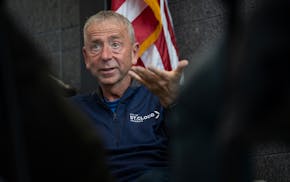A revelatory exchange in one of the season's many gubernatorial candidate debates occurred on Sept. 15, when a question via video was posed to the candidates by state economist Tom Stinson:
"What role if any should state government play in rebuilding the skills of the unemployed, and the long-term unemployed, so that they can be employable in the future?"
Republican candidate Tom Emmer had a ready answer: "Government definitely has a role, but government's role right now is to get out of the way. ... Let people keep more of their resources and allow people in the marketplace to create new jobs."
That's a response rich in Republican orthodoxy but poorly attuned to what's ahead for the Minnesota workforce. State employment projections say new jobs for low-skill entry-level workers won't be in huge supply. Fewer than 250,000 new jobs are forecast for the entire decade -- modest compared with the booms of the 1980s and 1990s. But replacements for the relatively well-educated baby boomers who are soon to retire will be highly sought-after. Projections say that nearly 640,000 existing jobs will need new incumbents by 2020.
Taken together, 70 percent of the new and replacement jobs forecast to open in the next decade will require some post-high school education, according to Stinson and state demographer Tom Gillaspy. That's a stunning change since the 1970s, when only 28 percent of jobs required some college study.
Many Minnesota job openings in the 2010s will be filled by people who are already in the workforce and who obtain additional training. Some ought to be filled by today's unemployed -- many of whom will need more training before they can apply.
Fortunately, for several decades, Minnesota has been adept at boosting the job skills of both the employed and the unemployed -- and state government has been at the heart of that success story. Job training is central to the mission of the Minnesota State Colleges and Universities, whose 54 campuses in 47 communities are charged with adapting their programs to meet local employers' needs.
In addition, since the early 1980s, state government has offered specially tailored training opportunities both to the recently unemployed and to employers. The Minnesota Job Skills Partnership, which serves the already employed and their employers, and the Dislocated Worker Program, which operates through a network of WorkForce Centers and independent grantees, have consistently received high marks from the businesses and workers they assist.
Both steer workers to the accredited educational institutions best positioned to meet their needs. In about 80 percent of cases, those institutions are part of the state-funded MnSCU system, said Job Skills Partnership director Paul Moe.
The Dislocated Worker Program has been going strong, doubling to 30,000 this year the number of people it serves compared with two years ago. Still, it has seen a 13 percent cut in the state share of its funding. (About 40 percent comes from the federal government.)
The Jobs Skills Partnership has sustained even deeper cuts, despite undiminished employer appetites for its training grants. Given that employers must supply a matching contribution -- often at a 2-1 ratio or higher -- to receive a Jobs Skills Partnership grant, the continued demand during an economic downturn attests to the growing need for workers with specialized skills.
Minnesota's higher education institutions have lost more than $150 million in state funding in the last two years. Candidate Emmer's budget plan would whack another $400 million in 2012-13 -- a 14 percent cut. By comparison, DFL candidate Mark Dayton and the Independence Party's Tom Horner both say they aim to increase higher-education funding.
The Job Skills Partnership and the Dislocated Worker Program were part of a multipronged strategy developed by the late Gov. Rudy Perpich in 1983 for spurring what might otherwise have been a slow recovery from the recession of 1980-81. It served Minnesota well then. Today's state leaders would do well to study that history.

Kudos to St. Cloud's longtime mayor
Readers Write: Ethnic studies curriculum, public notice laws, student protests


